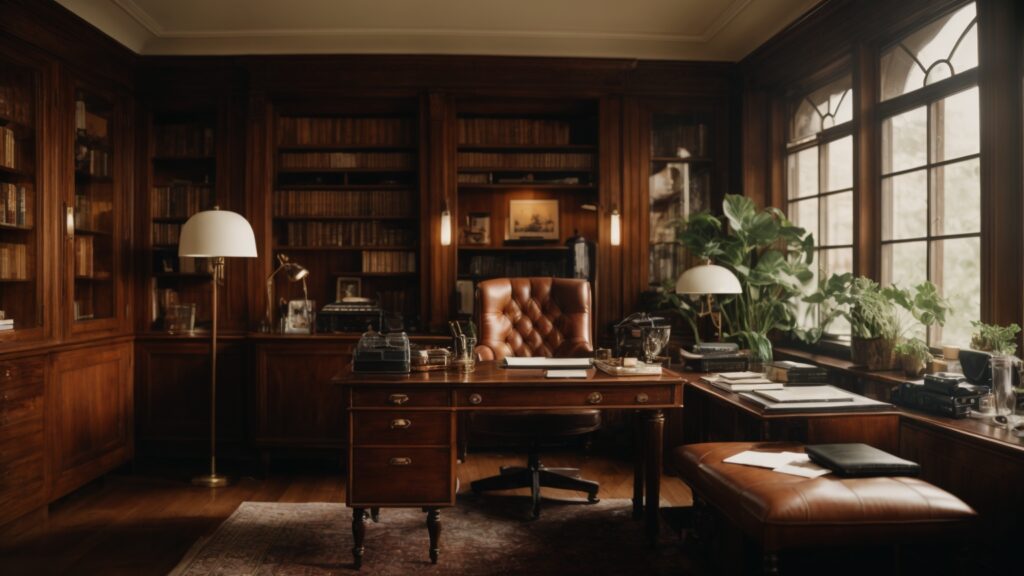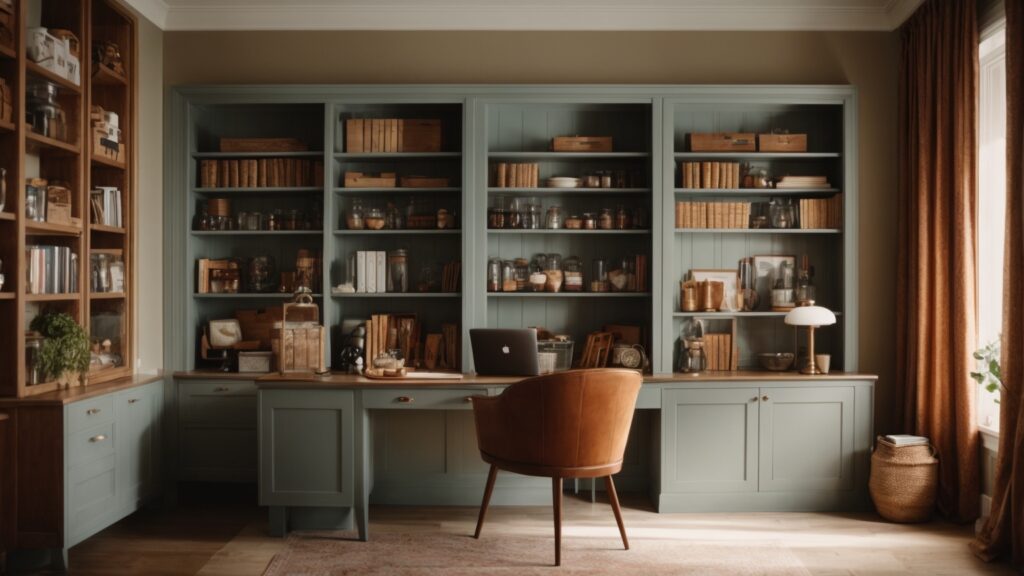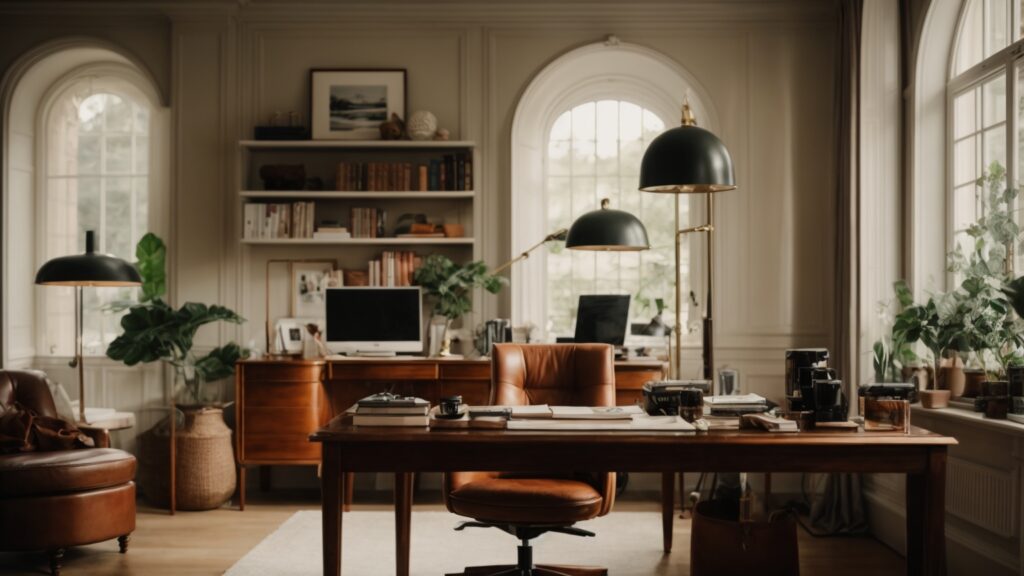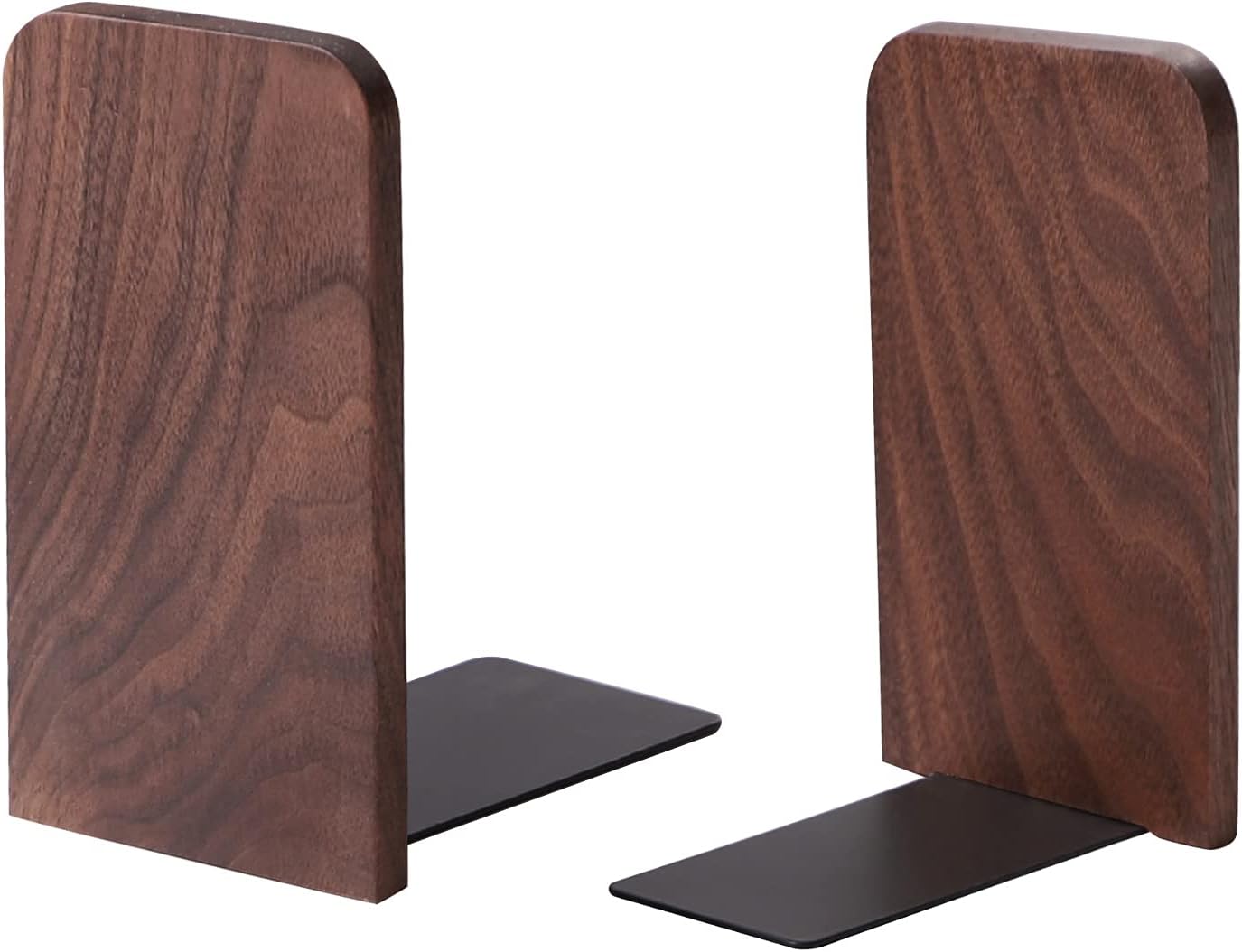Estimated reading time: 17 minutes
Introduction
The allure of a classic home office is undeniable in today’s ever-evolving work environment. By seamlessly integrating traditional home office ideas with modern home office ideas, this space not only fosters productivity but also enhances personal style. With rich wood tones and luxurious textiles, the classic home office sets a tone of refined elegance, making it more than just a workspace—it becomes a centerpiece of daily life. Essential elements like a sturdy office desk and comfortable desk and office chair set contribute to both the functionality and the aesthetic appeal of the area, ensuring a spacious home office that meets all needs.
Design studio quality and home designed aesthetics are increasingly influential in shaping home office design ideas, merging traditional design with cutting-edge modern home office ideas. From San Francisco home setups with panoramic corner office views to more intimate spaces that embody dream home office vibes, each design choice is crafted to support well-being and creativity. Incorporating art deco elements or a rosewood desk that commands the back wall, every detail is carefully selected to create a harmonious home environment that resonates with both personal and professional life.
Key Takeaways
- A classic home office seamlessly blends traditional design with modern functionality.
- Key elements include rich wood tones, luxurious textiles, and a warm color palette.
- Personal touches and decorative elements are crucial for a personalized workspace.
- Designing a classic home office involves considering both aesthetics and practicality.
- The space should inspire productivity and creativity and contribute to overall well-being.
- Classic home office designs are adaptable to various room sizes and functions.
Designing Your Classic Home Office: A Blend of Comfort and Functionality
Designing a classic home office is more than just creating a space for work; it’s about striking the perfect balance between comfort and functionality. This balance is crucial because your home office is not just a place to complete tasks but a space where you spend significant hours of your day. A well-designed classic home office should be an oasis of productivity, inspiring creativity while providing the comfort needed for long work sessions.
Case Study: Consider the case of a San Francisco-based interior designer who transformed a small room into a luxurious yet practical home office. By incorporating traditional design elements like a mahogany desk and a leather upholstered chair, along with modern amenities like high-speed internet and ergonomic design, the space became a perfect example of a classic home office blending old-world charm with new-world needs.
Choosing the Right Furniture for a Classic Look: Including Warm Wood and Soft Chairs
Selecting the right furniture is crucial when creating a classic home office. The ideal pieces should harmonize warm wood finishes with comfortable seating, serving an aesthetic and functional purpose. For instance, an oak desk, known for its ample workspace, is a quintessential choice. It combines practicality with the warmth and sophistication of wood.
Accompanying this, a leather desk chair is not only about ergonomic support for those long work hours but also adds elegance to the space. Furthermore, bookshelves are essential; they are not just for storage but also serve as a display area, adding character to the room. These shelves can house a mix of professional books and personal decorative items, making the space feel professional and personal. This thoughtful combination of furniture pieces ensures that your classic home office is visually appealing and a comfortable and productive environment.
Lighting and Decor: Setting the Right Mood
Lighting plays a pivotal role in setting the mood of your home office. Combining a pendant light for overall ambiance and a desk lamp for task lighting can create a focused yet comfortable environment. Additionally, incorporating decorative elements like an area rug or art pieces personalizes the space, making it warm and inviting.
Organizational Tips for a Classic Home Office
Organization is a key element in the functionality of a classic home office. To achieve an organized workspace, consider incorporating built-in cabinets or filing systems, which are excellent for keeping important paperwork neatly sorted and easily accessible. Additionally, placing a table lamp on your desk serves a dual purpose. Not only does it provide essential lighting for your tasks, but it also acts as a decorative element, enhancing the overall aesthetic of the room.
Furthermore, for those smaller office supplies, decorative boxes or trays can be exceptionally useful. They help keep your desk clutter-free and add a touch of style and personality to your workspace. By integrating these organizational tips, your classic home office can maintain its elegance while being highly functional.
The design choices in a classic home office should focus on creating a harmonious balance between style and practicality. By carefully selecting furniture, lighting, and decor that reflects a classic aesthetic while addressing functional needs, you can craft a workspace that is efficient and timeless in its appeal.

Essential Elements for a Classic Home Office Design
When it comes to designing a classic home office, certain key components are essential to create a space that is both aesthetically pleasing and functional. A classic home office design often revolves around traditional aesthetics, blending them with modern functionality to create a workspace that is efficient and timelessly elegant.
Must-Have Items for a Classic Home Office
- Traditional Wooden Desk: A classic design staple, offering functionality and a timeless look.
- Ergonomic Leather Chair: Balances comfort with a traditional aesthetic.
- Elegant Bookshelves: For organizing books and displaying decorative items.
- Classic Table Lamp: Provides task lighting and adds a touch of sophistication.
- Decorative Rugs and Curtains: Enhance the warmth and texture of the space.
- Art Pieces: Personalize the office and enhance its classic appeal.
Selecting Timeless Furniture Pieces
Choosing furniture that exudes a timeless charm is crucial in a classic home office. An oak or mahogany desk paired with a leather upholstered chair provides comfort and functionality and adds an air of classic elegance. Bookshelves in dark wood tones can offer practical storage while contributing to the traditional feel of the room.
“As with any timeless design, a classic home office should feel collected, not decorated. It’s about choosing pieces that are as functional as they are beautiful,” notes a renowned interior designer.
The Role of Color and Texture in Classic Design
Color and texture play a significant role in classic home office design. A palette of neutral colors, like beiges and browns, can create a warm and inviting atmosphere. Textural elements like wood grains, leather, and woven rugs add depth and interest to the space, making it feel more lived-in and cozy.
Artwork and Decorations that Enhance the Classic Aesthetic
Incorporating artwork and decorative elements is key to personalizing a classic home office. Traditional art pieces, vintage finds, and decorative objects can reflect personal style and interests, adding layers of character to the office.
Creating a classic home office involves carefully selecting furniture, color schemes, and decorative elements. Timeless furniture pieces, a warm color palette, and personal touches through art and decor are the cornerstones of this enduring design style. By combining these elements, you can create a functional and elegantly refined home office.
How to Set Up a Practical and Stylish Home Office in a Small Space
Creating a practical and stylish home office in a small space is about maximizing every inch while maintaining a sense of style. Choosing furniture and decor that serves your functional needs and reflects your style and turning a limited area into a productive and inviting workspace is crucial.
Strategies for Space-Efficient Design
- Opt for Multi-functional Furniture: Choose pieces that serve more than one purpose.
- Utilize Vertical Space: Install shelves and wall-mounted storage solutions.
- Select Streamlined Desks: Look for desks with built-in storage to minimize footprint.
- Embrace Natural Light: Arrange your workspace near a window to make the space feel larger.
- Incorporate Reflective Surfaces: Use mirrors to create an illusion of more space.
- Choose Light Colors: Lighter color palettes can make a small space feel more open.
Furniture that Saves Space Without Sacrificing Style
The right furniture can make all the difference in a small home office. Look for functional and stylish pieces, like a compact corner desk or a foldable work table. These options provide the necessary workspace without overwhelming the room. A slimline bookshelf or hanging cabinets are also great for storage while maintaining a sleek look.
Comparison of Space-Saving Furniture Options
| Furniture Type | Description | Benefits |
|---|---|---|
| Compact Corner Desk | Fits snugly in corners, offering ample workspace | Maximizes floor space; ideal for small rooms |
| Foldable Work Table | It can be tucked away when not in use | Versatile; saves space when needed |
| Slimline Bookshelf | Narrow, tall design for books and decorative items | Utilizes vertical space; adds style |
| Hanging Cabinets | Mounted on walls, perfect for storing office supplies | Keeps floor clear; adds to room aesthetics |
Creative Storage Solutions for Small Spaces
Innovative storage solutions are key to maintaining organization in a small home office. Think outside the box with under-desk storage units, wall-mounted file holders, and decorative baskets for loose items. These solutions keep your workspace clutter-free and add a touch of personal style.
Designing a small home office requires careful selection of furniture and creative use of space. By choosing multi-functional and space-saving furniture, utilizing vertical space, and incorporating smart storage solutions, you can create a practical and stylish home office, even in the smallest of spaces.

Incorporating Warm Wood and Comfy Seating into Your Home Office
In crafting a classic home office, incorporating warm wood and comfy seating plays a pivotal role. These elements add to the aesthetic appeal and significantly enhance the space’s comfort and functionality. Warm wood brings a sense of warmth and timelessness, while comfortable seating is essential for maintaining productivity during long work hours.
Best Choices for Wood Furniture and Comfortable Seating
- Solid Wood Desks: Oak or mahogany desks are durable and add an elegant touch.
- Ergonomic Leather Chairs: Provide comfort and style, perfect for long working hours.
- Wooden Bookshelves: Offer functional storage and display space, contributing to the classic look.
- Wooden Filing Cabinets: Keep your documents organized while adding to the warm atmosphere.
- Comfortable Lounge Chairs: Ideal for breaks or reading, adding a cozy element to the office.
- Soft, Plush Rugs: Enhance the comfort and look of the office floor.
Selecting Wood Types and Finishes
The choice of wood type and finish can significantly impact the overall ambiance of a home office. Opt for woods like oak, mahogany, or cherry for their durability and classic appeal. Finishes in natural or darker tones bring out the wood’s beauty and add a sense of richness to the office space.
Ergonomic Yet Classic Seating Options
When it comes to seating, combining ergonomics with classic design is key. An ergonomic office chair upholstered in fine leather or plush fabric provides necessary support during work and complements the office’s classic aesthetic.
“A home office should be a sanctuary where functionality meets comfort. The right blend of warm wood furniture and comfortable seating can transform a workspace into an area of inspiration and productivity,” states a renowned interior designer.
The thoughtful integration of warm wood furnishings and comfortable seating is essential in creating a classic home office. These elements provide practical benefits and contribute significantly to the overall ambiance of the space, making it both inviting and conducive to productivity.
Transforming a Guest Room into a Classic Home Office
The transformation of a guest room into a classic home office is an ingenious solution for those needing a dedicated workspace at home. This approach maximizes available space and creates a functional and stylish work area that doesn’t compromise the room’s original purpose.
Steps for Converting a Guest Room
| Step | Description | Importance |
|---|---|---|
| Assess the Space | Evaluate the size and layout of the room | Determines the feasibility of the conversion |
| Plan for Dual-Use | Design the space to serve as both a guest room and an office | Maximizes functionality |
| Choose Multi-functional Furniture | Select furniture that can serve various purposes | It saves space and provides versatility |
| Optimize Storage | Implement smart storage solutions | Keeps the room organized and clutter-free |
| Maintain a Comfortable Aesthetic | Decorate in a way that is welcoming to guests | Ensures the room remains inviting |
Design Considerations for Dual-Purpose Rooms
In creating a dual-purpose room, it’s vital to balance the needs of a home office with the comfort of a guest room. Selecting a desk that doubles as a nightstand or a Murphy bed that can be stowed away when not in use are smart choices. Integrating adequate storage solutions while maintaining an inviting atmosphere is key.
“As someone who frequently hosts guests, converting our guest room into a multi-functional space was challenging but rewarding. It’s all about finding the right balance between a productive work area and a cozy retreat for guests,” shares a homeowner who successfully made this transformation.
Case Study: Consider the case of a homeowner who transformed their rarely used guest room into a multi-functional space. Initially, the room had a bed and a small dresser. After the transformation, it featured a fold-down desk, built-in shelves, and a sofa bed, effectively serving as an office and a comfortable space for guests.
Transforming a guest room into a classic home office presents numerous advantages. It offers a practical solution for space limitations, ensuring the room serves multiple purposes without sacrificing style or functionality. By carefully selecting furniture and decor, any guest room can be effectively converted into a comfortable and efficient home office that welcomes both work and guests.
The Evolution of Home Office Design: From Traditional to Modern
The design of home offices has undergone a significant transformation over time, evolving from traditional styles to encompass modern elements. This evolution reflects changes in work habits, technological advancements, and aesthetic preferences. Understanding this progression provides insights into blending the best of both worlds in today’s home office designs.
Key Differences Between Traditional and Modern Designs
- Furniture Style: Traditional designs favor ornate wooden furniture, while modern designs lean towards minimalistic and sleek pieces.
- Color Schemes: Traditional offices often have darker, richer colors, whereas modern designs use lighter, more neutral palettes.
- Technological Integration: Modern designs incorporate more technology-friendly features than book-focused traditional designs.
- Layout and Functionality: Traditional offices are more formal and segmented, while modern designs emphasize open spaces and multipurpose areas.
- Decorative Elements: Classic designs feature more decorative and detailed elements, while modern designs focus on simplicity and functionality.
Incorporating Modern Elements into a Classic Design
Blending modern elements into a classic home office design can create a harmonious balance. This can include introducing ergonomic office chairs and desks with built-in technology docks into a traditionally styled room. Using contemporary art alongside classic pieces adds a fresh twist to the design.
Case Study: One homeowner successfully merged a traditional wooden desk with a high-tech ergonomic chair and modern lighting fixtures, creating an aesthetically pleasing and functional workspace. This blend of old and new elements exemplifies the potential of combining traditional and modern designs.
Technology Integration in Modern Home Offices
Modern home offices place a significant emphasis on integrating technology seamlessly. This includes features like built-in cable management systems, smart lighting, and wireless charging stations, all designed to support modern work tools and enhance productivity.
Future Trends in Home Office Design
Home office design trends will likely focus on sustainable materials, adaptive furniture, and advanced technological integration. The emphasis will be on creating spaces that are aesthetically pleasing, environmentally conscious, and highly functional.
The evolution of home office design from traditional to modern styles reflects changing needs and preferences. Today’s designs often merge the best aspects of both, incorporating the elegance of traditional elements with the functionality of modern innovations. This ongoing evolution ensures that home offices remain productive workspaces and reflective of personal style and the latest design trends.

- Non-Slip Bookends
- Heavy Duty Wooden Bookend Support
- Books and Movies (Walnut 1 Pair)
Conclusion
The classic home office has evolved into a harmonious blend of traditional home office design and modern desk innovations, striking the perfect balance between aesthetic elegance and functional utility. This space, meticulously curated with traditional home office furniture and contemporary touches, serves not just as a work area but as a testament to refined interior design. With choices like a robust office desk and an accent of a swivel chair, it’s designed to enhance productivity while maintaining a distinctly masculine and elegant office appeal.
Incorporating traditional home office design ideas, such as gallery walls and pieces of furniture that speak of timeless style, the classic home office also embraces modernity by integrating design inspiration from mezzanine office setups or built-in desks. The strategic placing your desk or adding a floor lamp can transform the space into a bright home office. This seamless integration of old and new ensures that your home office is not only practical but also a vibrant and inspiring home office space.

James Dunnington leads the James Dunnington Collection, featuring five unique blogs: a practical Pet Care Guide, an enlightening Ancient History Blog, a resourceful Home Improvement Guide, a cutting-edge Tech Innovation Guide, and a strategic Online Money Making platform. Each site delivers valuable insights designed to empower and inform. For updates and more tips, visit our Contact Us page to sign up for our newsletter, ensuring you never miss out on the latest content from any of these dynamic fields.

